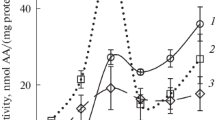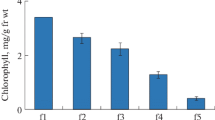Abstract
Ascorbate oxidase activity and immunoreactivity were evaluated in crude tissue extracts obtained from callus cell cultures induced by green zucchini sarcocarp and grown in the presence of tunicamycin, a powerful N-glycosylation inhibitor. Tunicamycin at 2 or 4 μg ml−1 blocked cell growth within a couple of weeks, although a sustained cell viability was observed in the same period. A significant inhibition of total protein synthesis was observed at 10 and 15 days of culture time, with a decrease of 30% and 43% respectively when cells were grown in the presence of 2 μg ml−1 tunicamycin, and of 48% and 57% respectively when the tunicamycin concentration was 4 μg ml−1. After the same culture times ascorbate oxidase specific activity assayed in crude tissue extracts showed increases of about 1.9-fold and 3.5-fold (10 days) and 1.7-fold and 3.1-fold (15 days) at 2 and 4 μg ml−1 tunicamycin, respectively. Ascorbate oxidase mRNA levels, however, did not appreciably differ between control and treated samples, measured at the same growing times. Lectin-blot, based on the use of concanavalin A, indicated a marked decrease of glycosylated proteins in tunicamycin-treated cultures. As judged by immunoblot, anti-native ascorbate oxidase antibodies scarcely recognized the enzyme expressed in tunicamycin-treated cells; on the contrary, anti-deglycosylated ascorbate oxidase antibodies were more reactive to the enzyme expressed in tunicamycin-treated cultures.
Similar content being viewed by others
References
Chichiriccò G, Cerù MP, D'Alessandro A, Oratore A, Avigliano L (1989) Plant Sci 64: 61-6.
Butt VS (1980) In The Biochemistry of Plants: A Comprehensive Treatise. Metabolism and Respiration. (Davies PJ, ed) pp 85-95. New York: Academic Press.
Lin LS, Varner JE (1991) Plant Physiol 96: 159-65.
Messerschmidt A, Ladenstein R, Huber R, Bolognesi M, Avigliano L, Petruzzelli R, Rossi A, Finazzi-Agrò A (1992) J Mol Biol 224: 170-205.
D'Andrea G, Bouwstra JB, Kamerling JP, Vliegenthart JFG (1988) Glycoconjugate J 5: 151-7.
D'Andrea G, Salucci ML, Pitari G, Avigliano L (1993) Glycobiology 3: 563-5.
Esaka M, Imagi J, Suzuki K, Kubota K (1988) Plant Cell Physiol 29: 231-5.
Esaka M, Fukui H, Suzuki K, Kubota K (1989) Phytochemistry 29: 1547-9.
Cho HJ, Aimi T, Paik SY, Murook Y (1989) J Ferment Bioeng 68: 193-9.
Pitari G, Chichiriccò G, Marcozzi G, Rossi A, Maccarrone M, Avigliano L (1993) Plant Physiol Biochem 31: 593-8.
Ohkawa J, Okada N, Shinmyo A, Takano M (1989) Proc Natl Acad Sci USA 86: 1239-43.
Esaka M, Hattori T, Fusjisawa K, Sakajo S, Asahi T (1990) Eur J Biochem 191: 537-41.
D'Andrea G, Maccarrone M, Oratore A, Avigliano L, Messerschmidt A (1989) Biochem J 264: 601-4.
Elbein AD (1987) Annu Rev Biochem 56: 497-534.
Duncan DR, Widholm JM (1990) In Methods in Molecular Biology: Plant Cell and Tissue Culture. (Pollard JW, Walker JM, eds) pp 29-37. Clifton: Humana Press.
Avigliano L, Vecchini P, Sirianni P, Marcozzi G, Marchesini A, Mondovî B (1983) Mol Cell Biochem 56: 107-12.
Bradford MM (1976) Anal Biochem 72: 248-54.
Edge ASB, Faltynek CR, Hof L, Reichter LE Jr, Weber P (1981) Anal Biochem 118: 131-7.
Campbell DH, Garvey JS, Cremer NE, Sussorfd DH (1974) In Methods in Immunology. pp 189-91. Reading: Benjamin WA Inc.
Logemann J, Schell J, Willmitzer L (1987) Anal Biochem 163: 16-20.
Rossi A, Messerschmidt A, Petruzzelli R, Finazzi-Agrò A (1988) Acts of the 34th Congress of the Italian Society of Biochemistry, p 131. Padua (Italy).
Maccarrone R, Rossi A, D'Andrea G, Amicosante G, Avigliano L (1990) Anal Biochem 188: 101-4.
Laemmli UK (1970) Nature 227: 680-5.
Merril CR, Goldman D, Sedman SA, Ebert MH (1981) Science 211: 1437-8.
Burnette WN (1981) Anal Biochem 112: 125-203.
Young PR (1989) J Immunol Methods 121: 295-6.
Lis H, Sharon N (1993) Eur J Biochem 218: 1-27.
Mahoney WC, Duksin D (1979) J Biol Chem 254: 6572-6.
Lerouge P, Fichette-Lainé A-C, Chekkafi A, Avidgor V, Faye L (1996) Plant J 10: 713-9.
Author information
Authors and Affiliations
Rights and permissions
About this article
Cite this article
Pitari, G., D'Andrea, G., Salucci, M.L. et al. Effect of tunicamycin on the activity and immunoreactivity of ascorbate oxidase (Cucurbita pepo medullosa) expressed in cultured green zucchini cells. Glycoconj J 15, 777–782 (1998). https://doi.org/10.1023/A:1006943412709
Issue Date:
DOI: https://doi.org/10.1023/A:1006943412709




